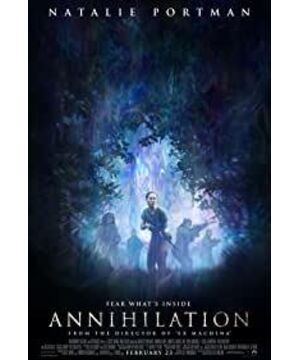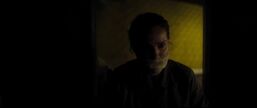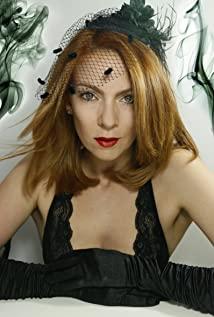A friend of mine wanted me to write an article about "Annihilation", but I was too lazy to write it. After the heat gradually passed, I decided to give up. Later, when I saw that the film was introduced for public screening, I wondered if I should write something while it was being released.
But the mainland release version inevitably deletes some bloody and horrifying scenes, choose discretionary.
Alex Garland is still a new director. The only feature films he directs are "Mechanic Ji" and this "Annihilation", both of which are science fiction themes. However, both films were very loud and well received.
Jialan's sci-fi style is quite exquisite, full of stagnant ingenuity. "Mechanic Ji" is a secret room movie that describes the story of two men and a female artificial intelligence in a room. It uses the uncanny valley effect to create a thrilling atmosphere, and explores the chaotic relationship between the "self" and the "creation" through the cramped narrative space. Of course, it is inevitable to carry the bad roots of human nature.
Oscar Isaac, who played the role in "Machines", can be said to be Garland's "old partner". In this film, he continues to play Natalie Portman's missing husband. "Annihilation" is an upgrade of the previous work in the image space, and the style has also been further improved.
The film is adapted from Jeff Van der Meer's science fiction novel "The Forsaken Southland". This novel defeated the "Three-Body" and won the Nebula Award, and was later introduced to China. The novel itself is inherited from the "New Weird" movement, or genre. And this genre was deeply influenced by early new wave science fiction, western fantasy, urban novels, especially Lovecraft’s "Cthulhu myth", and developed in an inclusive manner. Therefore, both the original text and the screen of the movie show the interesting style of Cthulhu and the new monster. More importantly, Jialan obviously found the material that suits her way of expression.
Literary adaptations to movies can be roughly divided into three types: Literal, Faithful and Loose. However, many movies actually use a variety of methods to rearrange the original work, rather than just stick to one. "Annihilation" extracts part of the characters and the main story of the first part of "The Forsaken South," and the plot and setting details are drastically reorganized. Including Lena's ethnic skin color, the supporting role's identity background (which is a big suspense in the original book), Kane and even the ending of the whole story are contrary to the original book. But the film well retains the strange and blurred atmosphere and "nihilism" spirit of the original. Loosely shaped, faithful to God.
This spirit of "nihilism" naturally originated from the myth of Cthulhu, and sometimes became the subject of "New Strange Tales".
Cthulhu Mythos (Cthulhu Mythos) is based on a series of novels by American writer Howard Philip Lovecraft, and is a system of overhead myths perfected by August William Dresser and many writers. Emphasizing that "the oldest and most original emotion of mankind is fear, and the oldest and most original fear is the fear of the unknown." This theme is presented in many horror, fantasy, horror, and science fiction works under the Cthulhu system.
Lovecraft, fans called the craftsman. Born on August 20, 1890 and died on March 15, 1937, he is an American writer of bizarre novels. He wrote a large number of novels throughout his life. The last ten years of his life were particularly prolific. "Dexter Incident", "Cthulhu's Call" and other works are the most popular, and they are also the foundation of the Cthulhu myth.
He received little attention when he was alive, but his reputation grew after his death. Together with Poe, he was regarded as the greatest horror novelist of the 20th century. People like Stephen King, Lansdale, Ito Junji, Alan Moore, Neil Gaiman and others are all deeply influenced by it. For example, in the movies "Strange Forms", "Terrorizing Black Hole", "Raising Ghosts and Eat People", and the "SCP Foundation" archives, many Cthulhu elements can also be seen.
One of the core settings of "The Myth of Cthulhu" is "Book of Necro", which is a fictional magic book about demon rituals and lost knowledge. Sometimes it will be the McGeffen in the book, and sometimes it will be the curse that everyone is afraid to avoid. What unfolds from this is a series of "unspeakable existence" stories about the old rulers, outer gods, and old gods. Works that absorb the concepts or elements of Cthulhu will always have a strong weird and ancient atmosphere and content that is contrary to common sense and incomprehensible. If there are supernatural existences or special creatures, they must be extremely weird, disgusting, cold and possessive. The look of oppression.
"Cthulhu Mythology" is like Greek mythology and Nordic mythology. Gods have their own personalities and ways of doing things. A complete system supports the background stories they carry, and their creation is relatively free. There is no obvious dispute between good and evil in the "Cthulhu Mythology". There is a value that transcends good and evil. As I once said, the dark universe is the last unknown place for mankind, and there will be no obvious concepts of good and evil.
But after Lovecraft's death, his good friend August William Dres established and perfected the mythological system of Cthulhu based on the purpose of this series of mysticist novels. Dres joined many of his own Christian values, dividing these ancient and powerful gods into four elements: earth, fire, water, wind, and there were also more obvious oppositions between good and evil camps, and more intense dramatic conflicts. This practice is considered by many fans as a betrayal of the love of craftsmanship, turning the originally unrestrained and imaginative horror world into a series of modern fantasy adventure stories. Therefore, many people do not recognize Drees's works, and only recognize the craftsmanship novels as orthodox.
The "Cthulhu Mythology" is characterized by ancient, evil, and unclear language. The most fascinating is the vague sense of horror and the ambiguous atmosphere of despair. The common theme of Lovecraft's novels is: the value of mankind in the universe is meaningless, and all exploration of the mysterious and unknown will lead to a catastrophic ending. Human beings often rely on the power of other powerful beings in the universe, but these beings have no interest in human beings-if not malicious.
This typical nihilistic feature can be clearly experienced in "Annihilation". For more than half of the story, the audience, like the five female players, didn't know what kind of existence they were facing. This was exactly the kind of unknowable horror. In the end, the survivor came to the lighthouse and saw a scene she couldn't understand. Similarly, the audience also needed to think positively to accept the impact of the picture. In fact, the film has eliminated most of the strong sense of despair in the original, but as a science fiction thriller, the ending scene of Kane and Lena is still chilling.
And many plots in the film reveal Cthulhu aesthetics, such as squirming intestines, flower-like skeletons, moss-covered flesh, and a lighthouse with a black hole. On the one hand, in terms of images, this visual design is quite post-modernist, challenging traditional aesthetics and rational thinking. On the other hand, it also implies the worthless vulnerability of human beings, just like the existence of Cthulhu.
Just as people who have seen the old rulers and those who have read "Book of the Necromancer" go crazy, the first 11 teams that enter the "X Zone" either have no life or lose their minds. I vaguely remember that in the original book, there were still "people" in the first 11 teams, but they soon died of cancer, or their personality changed drastically.
In the film, Lena and her team found the video of the previous team. They saw Kane and others brutally cut the stomachs of their teammates. The intestines inside were moving like snakes, while others fell into the scene when they saw this scene. In the mixed emotions of fear, obsession and fanaticism.
This kind of transcendental and bizarre urban grotesque is exactly the charming charm of the film "Annihilation" and its original work, "The Forsaken Southern Land", which adheres to the "new grotesque" style. The difference between the two is that the story in the original book is obviously more complicated, with a clear history and follow-up, and it seems more desperate. The film uses three nested structures of time and space, as well as the cold and beautiful audio-visual and the treacherous landscape, to make the story full of depth and metaphor.
The "X area" is covered by a huge film. People don't know the meaning of the existence of this film, because the physical substance can pass unimpeded, but some electromagnetic pulse signals and light are difficult to penetrate normally. From this point of view, it is more like a huge radiation shield, but very thin and transparent. When the movie shows this large film, it naturally takes into account the interference of light, so it is just like the bubbles we usually blow, with colorful colors flowing on the surface. The creation of this magnificent spectacle, like a poem on set, reveals the overall temperament of the film.
Hu Shaoyan said in "The Past and Present of New Strange Tales": Jeff Van der Meer, the author of "The Forgotten South," is not only a writer, but also an editor. He and his wife Ann van der Meer co-edited a collection called "New Strange Tales", which is divided into four parts: promotion, evidence, argumentation and experimentation, introducing a large number of works in the style of Neo Tales and this movement. Development context.
"New Strange Tales" now has two standard bearers, one is Jeff Van der Meer and the other is Ziner Miyevi. Jeff described the new strange story like this: an overhead world novel that takes the city as the stage. It subverts the common interpretation of concepts in traditional fantasy, and creates a design with both science fiction and fantasy elements starting from the real and complex real world. Certainly. Chainer also wrote in the paper: A blowout of high-quality fantasy works is happening around the world, or it is mainly appearing in the British fantasy fiction world. These works show bizarre, absurd, lifelike illusory reality, and a variety of writers also Are among the creations.
Miervi’s "Baslag Trilogy" is the most representative novel of the novel. It uses London during the industrial revolution in the 19th century as a template to create an imaginary city and covers European cities since modern times. Various political entanglements. At the same time, there are many peculiar humanoid races in the world of Basrag, including eagles, insect heads, frogmen, cactus tribes and so on. Because of its intertwined elements of fantasy, science fiction, flow, absurdity, etc., as well as the staggering detailed description and strong political color, the Baslag trilogy is called the model of the new strange story by the critics.
Jeff Van der Meer's "Ambergris City" series is also a different way, its dark and absurd atmosphere is chilling. This weird city is occupied by "fungi people", and the terrible spreading ability of fungal spores is their means of exercising terror and repressive rule. "Lost Southland" obviously continues Jeff's "obsession" with fungi.
——(Hu Shaoyan: The Past and Present of the New Weird Tan)
New Monster Tan originated from the new wave of science fiction movement that emerged in the 1960s and a series of non-conceptual novels represented by the myth of Cthulhu. However, in the new strange story, the monsters are more specific than the gods in the love of craftsmanship, and their characters are clearer and clearer. The setting is no different from what we often see in video games and fantasy stories. In fact, it is a kind of degradation. Dealt with, but easily accepted by others.
"Annihilation" is actually a degrading treatment of the original: the plot and the relationship between the characters are simplified, and there are even some ritual shots that are de-plotted. Then he added pen and ink to the visual design, with atmosphere and motif first. Jialan’s route is correct. For a story like "Lost Southern Land", a movie can't cover all of it. However, the original work itself wraps a cliché story in a superb form, so the film takes the story further. The complexity is simple, but more secrets are born.
Including the lighthouse scene at the end of the film is by far the most fascinating science fiction scene I have seen this year.
In essence, "Lost Southland" is still the story of aliens invading the earth. But to a certain extent, it, like the defeated "Three-Body" of its own Nebula Award, relies on science and imagination to subvert the conventional alien invasion story. Even the invaders of the two works came to the earth because of the terrible hometown problems. It's just that "Three Body" relies on the grand narrative and huge amount of foreshadowing, as well as the complex character motives combined with history to reflect this uniqueness. And "Annihilation" starts from the setting itself, combined with the style of "New Strange Tan", to depict another advanced invasion method.
Judging from the film alone, it is difficult to say whether these alien life is malicious, or purely out of instinct to mess up and copy the genes on the earth. But when sika deer’s horns really grow plum blossoms, when crocodiles evolve shark teeth, and when bears repeat the language of food, everything subverts our normal cognition and leads to the oldest and most profound philosophical questions. :who am I? Am I the one I was the last minute? This involves every conscious individual's definition of himself.
Therefore, "Annihilation" has a simple story and complicated propositions, and the excellent audiovisual level makes it enough to impress people through dialogue, spectacle and ending. This time, Jialan has dedicated sci-fi works above the standard. While maintaining a certain independent temperament, he also revealed a new Hollywood aesthetic style. Of course, in the film alone, this new image style is obviously influenced by Cthulhu and New Weird Tan. I personally like this tonality very much, and hope that he will continue on this road.
View more about Annihilation reviews











